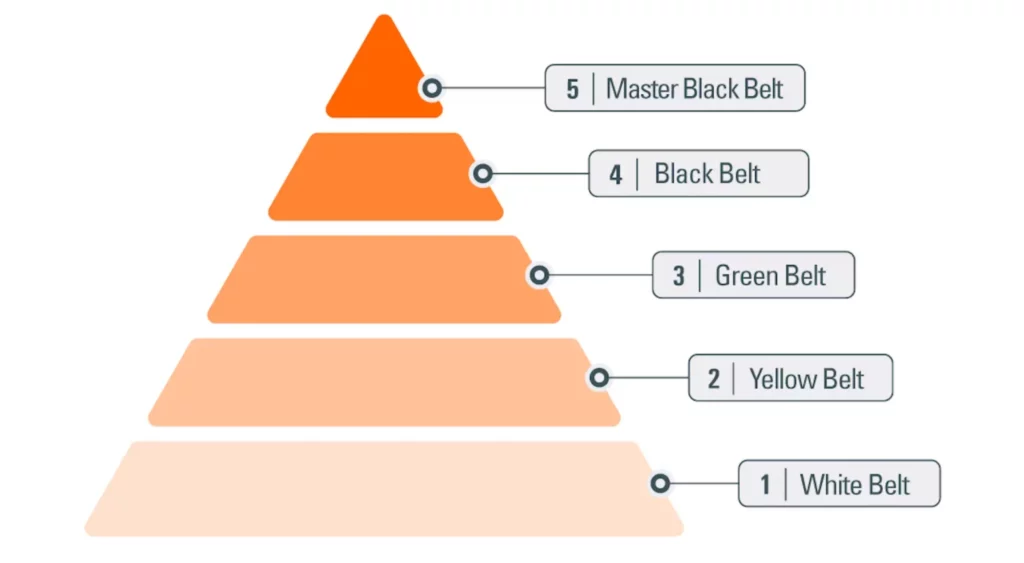Learn how Lean Six Sigma certifications can transform your organization’s efficiency. But look at the belt levels and their parents.
It has been said that we wear our karate belts or that there are different cores, which translate to different levels of skill, knowledge, and experience of a student. There is no single Lean Six Sigma certification process, there are no belts or even difficulties, but there are also different levels of workload, as well as the respective cores, which help determine the role their owners assume in a specific project.
“Six Sigma is a methodology and philosophy that aims for near perfection in products and processes.”Mikel Harry
And professionals with these certifications, called “belts,” are highly valued by companies that trust their skills and knowledge, despite the focus on process improvements, operational efficiency and cost reduction.
What are Lean Six Sigma certifications?
These are ways for organizations to improve efficiency, reduce defects, and improve the overall quality of all processes. And in this context, certified professionals can make a vital contribution to cost savings and sustainable business improvements.
Why? Because professionals with these certifications are trained to identify and eliminate waste, in addition to having the ability to reduce process variability. And this translates into higher quality products and services and more efficient processes.
Not only do they allow the company to reduce costs by being able to identify inefficiencies and suggest solutions, but they are also able to solve complex problems through the use of a structured, data-driven approach.
This means that companies with Lean Six Sigma certified teams can respond more quickly to market changes and, at the same time, implement a culture of continuous improvement within the organization. An improvement that, in turn, leads to greater customer satisfaction, which translates into greater customer loyalty and retention.

White Belt
This is the first level of the certification process, considered the most basic level. White belts interact with senior-level individuals as well as professionals in other key roles, and their role is to understand the fundamental concepts of Six Sigma.Therefore, participate in projects and tasks to solve problems related to quality management and loss reduction.
Yellow (Yellow Band)
This is the level where you begin to learn more about what Six Sigma is and how it is applied in the workplace. He is a professional who knows the fundamentals of this philosophy, but does not have the skills to lead projects.When writing, you can perform various project-related tasks, such as attending meetings, providing functional information, collecting data, and assisting with necessary implementations. Or help solve problems and complete projects.
Green (Green Belt)
Knowing that the higher the level, the greener the better, the more direct the support, the more is being provided through the analysis and resolution of quality problems, thus being involved in better quality projects. Their duties include assisting in reviewing data and suggestions submitted by lower-level employees.It is also capable of applying tools such as defining, measuring, analyzing, improving and controlling daily work problems.I work as a professional with very few years of experience, often leading a project directly related to my area of expertise/profession. Therefore, it is common for supervisors to undertake an initiative to improve a specific process or aspect of the business, through the application of techniques and tools that promote positive changes.
Black Belt
It is the top of the pyramid, that is, the one that comprises the philosophies and principles of Six Sigma, including support systems and tools. And, as an expert in specific elements of this methodology, he leads cross-functional projects, as well as acting as a mentor, trainer or consultant for one or more Green Belts who lead individual projects, as well as for Yellow Belts who perform support roles.Deeply aware of team dynamics, controlling the allocation of roles and responsibilities of the elements that constitute it and giving high priority to improving overall quality and increasing profits, he is a true agent of change within an organization that, depending on its size, may be one or more Black Belts.To become a certified Black Belt, a professional must obtain the Green Belt certification, which is achieved through fewer projects and a minimum of three years of professional experience in a less core area of knowledge.
Black Master
To be a Master Black, you need less than five years as a Black Belt or no resume and experience of less than 10 projects as a Black Belt. Treating themselves as elite professionals present in most organizations, only these individuals are needed to manage your Lean Six Sigma initiatives. As a rule, they do not manage projects, but rather lead the organization on the path of transformation, working directly with senior management and human resources to build long-term improvement strategies.

